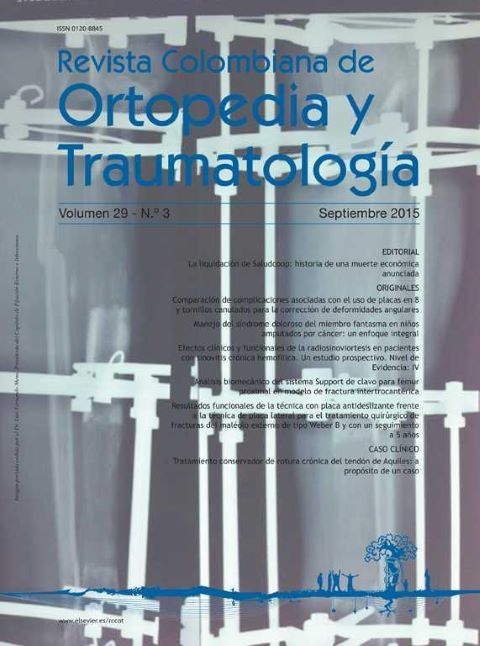Biomechanical analysis of a support system for proximal femur nail in an intertrochanteric fracture model
DOI:
https://doi.org/10.1016/j.rccot.2016.02.005Keywords:
compression fatigue test, proximal femur, intertrochanteric fractures, intramedullary fixationAbstract
Introduction: The intertrochanteric fractures of the proximal femur are presented mostly due to trauma in the elderly. The incidence of these fractures has been increasing in frequency in recent years due to the aging of the population. The purpose of this study was to determine the fatigue performance of the branded Support system for the treatment of intertrochanteric fractures of the proximal femur by biomechanical analysis.
Materials and methods: The analysis was performed on synthetic bone models with intertrochanteric fractures. The mechanical characteristics of the system were first determined using a static compression test, and then compression fatigue tests were performed to complete one million cycles or until a displacement of the femoral head of greater than 5 mm was produced.
Results: The results show that the fatigue strength of the Support system is sufficient in order to be able to withstand the loads to which it is subjected during the time from surgery to fracture healing.
Discussion: Further work is recommended to evaluate the performance ofthe system, where the main action of the muscles acting on the hip joint and in a simulated physiological environment is considered.
Evidence level IV.
Downloads
References
Gava R, Pérez-Hernández D, Corona-Fernández C, García-García J, Hernández-Vaquero D. Clavo Gamma en el tratamiento de las fracturas del macizo trocantérico. Estudio comparativo entre el clavo Gamma trocantérico y el Gamma 3. Rev Esp Cir Osteoart. 2005;40:7-12.
Formiga F, Pujol R. Mortalidad por fractura de fémur: analizando las causas de un viejo problema. Med Clin (Barc). 2005;124:55-6. https://doi.org/10.1157/13070458
Evans P, McGrory B. Fractures of the proximal femur. Clinical review article. Hosp Physician. 2002:30-8.
Rosenblum S, Zuckerman J, Kummer F, Tam B. A biomechanical evaluation of the Gamma nail. J Bone Joint Surg Br. 1992;74:352-7. https://doi.org/10.1302/0301-620X.74B3.1587875
Sanjuan-Cerveró R, Suárez-Varela MM, Sanchis-Sanegre J, Fenollosa-Gómez J. A Clinical Comparison between the Gamma® and the Claufitt® Nails in Unstable Proximal Femoral Fractures. Rev Esp Cir Ortop Traumat. 2007;51:325-34. https://doi.org/10.1016/S0482-5985(07)75568-2
Halder S. The Gamma nail for peritrochanteric fractures. J Bone Joint Surg Br. 1992;74:340-4. https://doi.org/10.1302/0301-620X.74B3.1587873
Heinert G, Parker M. Intramedullary osteosynthesis of complex proximal femoral fractures with the Targon PF nail. Injury. 2007;38:1294-9. https://doi.org/10.1016/j.injury.2007.05.010
Paraschou S, Anastasopoulos H, Rossas H, Papapanos A, Alexopoulos J, Karanikolas A, et al. Technical errors and complications of gamma nail and other cephalocondylic intramedullary nails in the treatment of pertrochanteric fractures: Prevention and treatment. Injury. 2009;40:S11-2. https://doi.org/10.1016/j.injury.2009.07.027
The weight of nations internet. Actualizado en 2012; consultado el 26 de febrero de 2014. Disponible en: http://www.lshtm.ac.uk/newsevents/news/2012/tackingpopulationweightcrucialforfoodsecurity.html
Nordin M, Frankel VH. Basic biomechanics of the musculoskeletal system. Philadelphia: Lippincott-Williams & Wilkins; 2001. p. 467.
Bermúdez A, Paoli M. Actividad física determinada por podometría en pacientes con síndrome metabólico. Rev Ven Endocrinol Metabol. 2008;6:24-30.
Eberle S, Gerber C, von Oldenburg G, Hungerer S, Augat P. Type of hip fracture determines load share in intramedullary osteosynthesis. Clin Orthop Relat Res. 2009;467: 1972-80. https://doi.org/10.1007/s11999-009-0800-3
Heiney J, Battula S, Njus G, Ruble C, Vrabec G. Biomechanical comparison of three second-generation reconstruction nails in an unstable subtrochanteric femur fracture model. Proc Inst Mech Eng H. 2008;222:959-66. https://doi.org/10.1243/09544119JEIM369
Pauwels F. Biomechanics of the normal and diseased hip. Berlin, Heidelberg: Springer; 1976. https://doi.org/10.1007/978-3-642-66212-6
Downloads
Published
How to Cite
Issue
Section
License
Copyright (c) 2024 Revista Colombiana de ortopedia y traumatología

This work is licensed under a Creative Commons Attribution 3.0 Unported License.




